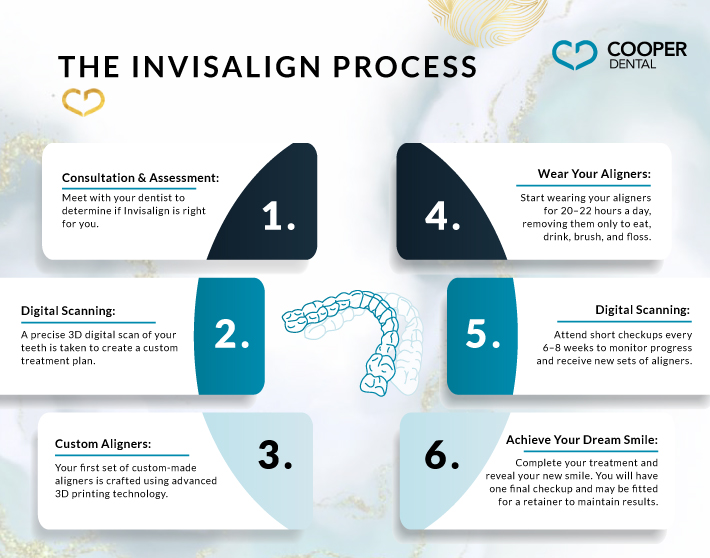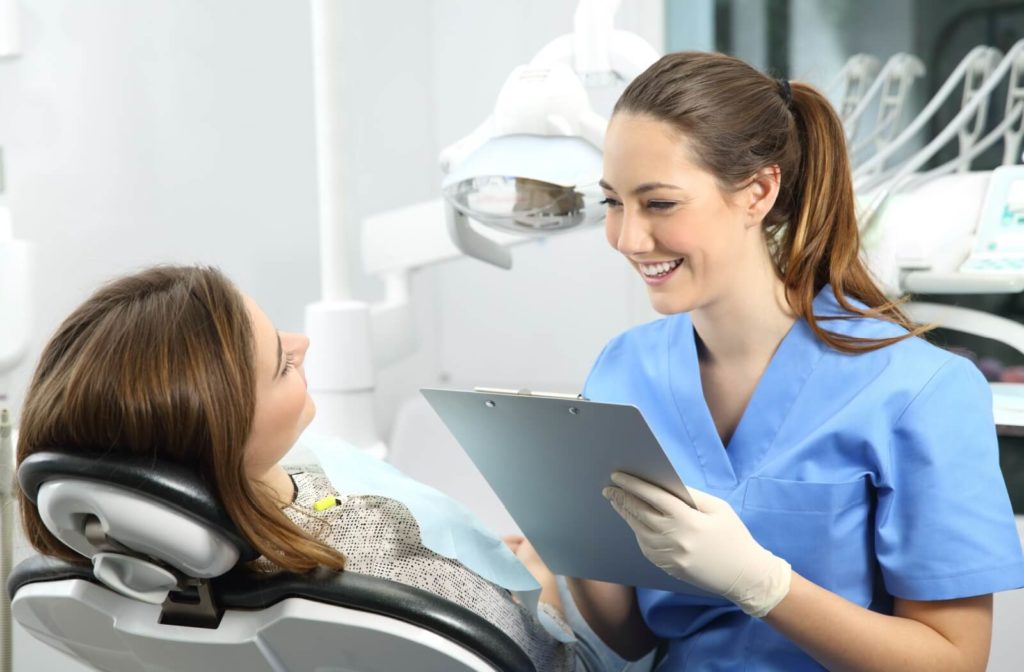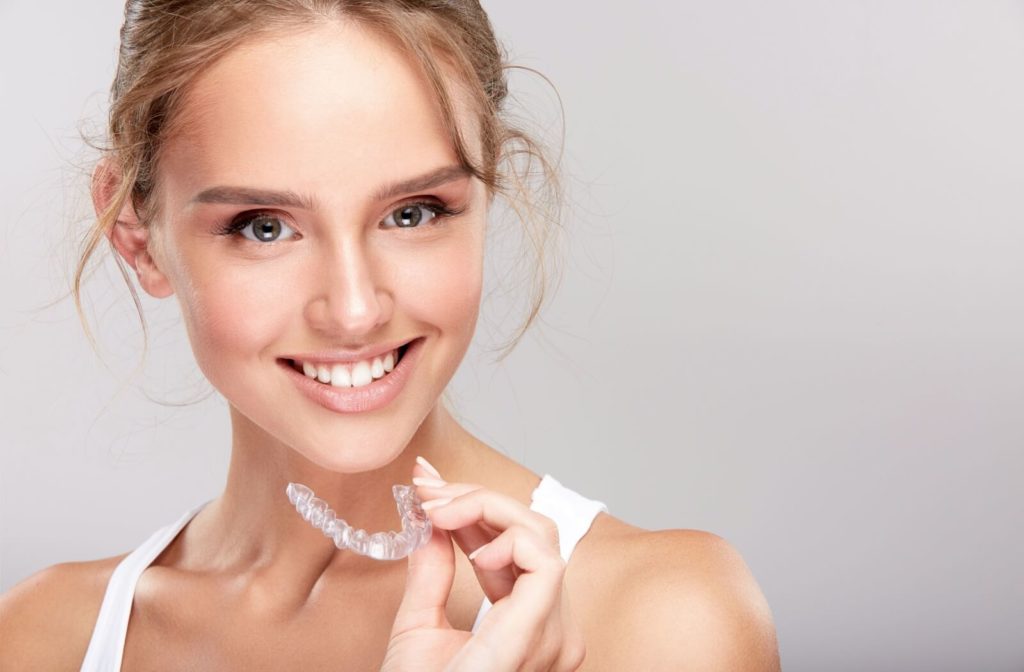With the field of dentistry continually advancing, we are here to demystify the science and practical benefits of Invisalign—an orthodontic treatment known for its discreet nature and comfort.
Treating misaligned teeth does more than just enhance your smile; it underpins oral health, oral function, and can even impact psychological well-being. If you are looking for an alternative to traditional braces, Invisalign could be just the thing for you.
Using a series of clear, custom-made, plastic aligners, Invisalign gently and gradually shifts your teeth into their desired position.
How Does Invisalign Move Teeth?
Invisalign’s success in straightening teeth lies in the precise application of controlled force. Unlike traditional braces that use brackets connected by wires to move teeth, Invisalign employs a series of custom-made, clear aligners. These aligners are designed to fit snugly over your teeth, applying targeted pressure to gradually shift teeth into their desired position.
The process involves changing to a new set of aligners approximately every 1–2 weeks, each set slightly different from the last, helping your teeth continue to move toward their final, correct alignment. This method not only offers a less intrusive alternative to braces but also allows for a more comfortable and aesthetically pleasing orthodontic experience, as well as no change in your oral care routine.
The Technology Behind Invisalign
At the heart of Invisalign’s efficacy is an approach that combines meticulous planning with quality materials. The process begins with a digital scan of your teeth, followed by crafting tailor-made aligners designed to the specifications of your smile. These aligners, virtually invisible and removable, work around-the-clock to guide your teeth into their optimal position.
The Aligner Crafting Process
Invisalign’s proprietary software, ClinCheck, enables dentists to forecast the treatment’s progress and fine-tune the aligners’ construction at each stage. Using 3D printing technology, a series of aligners—each slightly adjusted to nudge your teeth closer to their final alignment—are created.
The Role of SmartTrack Technology
The marvel behind the flexibility and fit of Invisalign aligners is the patented SmartTrack material. This elastic thermoplastic exerts the right amount of force on the right places to achieve controlled tooth movements with improved predictability—each aligner moves the teeth approximately 0.3mm.
The Invisalign Journey
Your Invisalign experience is a collaborative process with your dentist. Starting with an initial assessment to map your treatment plan, you will receive sets of aligners at regular intervals, each typically worn for 1–2 weeks. The periodic changes in aligners signify that your teeth are progressing according to the treatment’s strategic orchestration.
The Importance of Compliance
Your dedication to wearing the aligners for at least 20–22 hours a day is critical for treatment success. Skipping on the recommended wear time can prolong treatment and compromise outcomes. Think of each aligner as a rubber band being stretched, when it is removed, the teeth bounce back to their original position.
The aligners are only removed to eat, drink (except for water), and perform your oral hygiene routine.
Invisalign vs. Braces
Invisalign and traditional braces share the same purpose: correcting dental misalignments. Yet, their differences are what makes each approach relevant to different individuals. For example, you can think of traditional braces as a pull motion and aligners as a push motion.
Braces are conspicuous, fixed, and at times may be the more effective option for complex dental issues, but they can pose challenges to oral hygiene and dietary freedom. Invisalign, on the other hand, is often favoured for its unobtrusiveness and comfort, suitable for those with mild to moderate orthodontic needs.
It is important to note that traditional metal braces are often the only choice for moving teeth in more severe and complex cases.
Visibility & Comfort
Invisalign’s clear, almost invisible aligners give it a definitive edge over the visible brackets and wires of braces. The comfort quotient is another strong point, with the absence of metal parts that can cause irritation.
Oral Hygiene
One of the most noticeable differences between Invisalign and braces is the ease of maintaining oral hygiene. With Invisalign, you can brush and floss as you did before the treatment, whereas braces demand a more meticulous approach to avoid plaque buildup around the appliances.

Maintaining Oral Health During Invisalign Treatment
Keeping your teeth and aligners clean is pivotal during Invisalign treatment. Regular brushing and cleaning of aligners with specialized Invisalign cleaning crystals support your oral health and ensure the aligners remain clear and discrete.
Tips for Healthy Teeth & Clean Aligners
Brush your teeth after every meal or at the very least, rinse your mouth with water before reinserting your aligners, and do not forget to floss daily. You can use the Invisalign cleaning system or Polident Retainer Cleaner Tabs to keep your aligners free from bacteria and odour.
The Wider Spectrum of Invisalign Benefits
Invisalign’s reach extends beyond teeth straightening. From improved chewing and digestive problems to alleviating TMJ disorders, Invisalign goes beyond just aesthetic concerns.
Chewing & Digestion: Misaligned teeth can lead to improper chewing, which in turn affects digestion and overall nutritional intake. When teeth do not connect properly, food is not broken down into smaller particles. This then makes the digestive enzymes in the stomach work harder. Correcting these issues with Invisalign not only improves oral functionality but also supports better gastrointestinal health.
TMJ Disorder: Misalignment of teeth can place stress on the jaw since teeth do not connect properly. This off angle in the bite adds stress to the jaw joint, leading to pain, discomfort, and other temporomandibular joint (TMJ)-related symptoms. By correcting the alignment, Invisalign can help reduce this stress, offering a potential reprieve from TMJ discomfort.
Oral Health: Often the lower front teeth are crowded, which in turn results in excess tartar build up specific to this area. Poor alignment makes it difficult to brush and floss this part of the mouth. By aligning this area, it significantly lowers the risk of plaque buildup, tooth decay, and gum disease, leading to a healthier mouth and potentially reducing future dental costs.
Improve Tooth Wear Issues: Tooth wear is most evident on the front four upper and lower teeth. Since most people have crowding in this area, these eight teeth tend to bump into each other over time and get worn. This results in exposed dentin since the enamel layer has been ground away. By moving the teeth, the front bite will change favourably, thereby reducing the amount of tooth grinding in this area. This in turn, will save the front teeth from further chipping and breakage.

Embracing Your Invisalign Transformation
The choice between Invisalign and braces is a personal one, influenced by your orthodontic needs, lifestyle, and preferences. If you are considering taking the next step toward a radiant and healthier smile, the doors of Cooper Dental are open to guide you through the world of Invisalign.
Your smile’s potential is limitless with the alliance of modern orthodontic technology and the care and experience of our team. Contact us today to schedule a consultation with Dr. Cooper and get started. We can even show you a before and after picture of your new smile!




